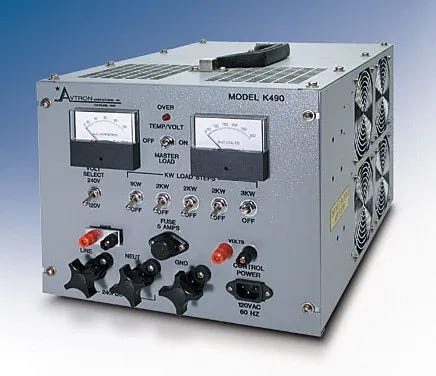Dear Mike,
It may be best to check pedestal voltage under load before plugging in. Is there an easy way to do this? —Don/Piano-tuna
Dear Don,
That’s a great idea, but likely beyond the scope of most RV owners. That’s because meaningful load testing can be time-consuming and complicated.
Here are the basics: There are at least two different types of load testing – static and dynamic – with the static load test being the gold standard. A static load test works by applying a specific/heavy current load over an extended period of time, typically minutes. A dynamic load test applies a very short pulse of current, which typically lasts only a fraction of a second, maybe a line cycle or two.
Static Load Tests
To perform a static load test on a budget, you can utilize something like a half-dozen 1200 to 1800 watt space heaters or hair dryers, or even a bank of incandescent light bulbs. I performed this type of load test for many years, and it can tell you a lot about the condition of the wiring – but getting a bunch of space heaters running at the same time is a bit cumbersome.
The big boy!!!
What I currently use for static load testing is much more elegant: an Avtron K490 10kW load bank which is switchable between 120 and 240 volts and can apply the load in 1,000 watt increments up to 10,000 watts via front panel switches. It has a bank of cooling fans that sounds like a swarm of angry bees and a big relay to apply the load via a single master switch.
Price of a purpose-built load bank like this one is around $3,000 to $4,000, so only someone doing power diagnostics like myself would ever own one. It’s also heavy to haul around, and requires custom-built power cables that can carry a full 80+ amp load without overheating. Finally, when gathering field measurements with a static load bank it’s possible to create hazardous situations, and there are some calculations involved to interpret the results. So I’ll save static load testing for advanced education for RV technicians and NEC studies.
Dynamic Load Tests
The second type is a dynamic (or impulse) load test using a Ground Loop Impedance Tester such as the SureTest Circuit Analyzer or Amprobe INSP-3. These work by applying a single cycle pulse of 5 to 15 amperes, which will load the electrical circuit just enough to predict the actual voltage drop at the outlet under 15- or 20-amp loads. You can then extrapolate these 20-amp results by 150% or 250% to predict voltage drops under 30- or 50-amp loads. It also calculates the impedance of the EGC ground bond connection as well as the load conductors.
While less complicated and inexpensive compared to a high-wattage static load bank, cost of a Ground Loop Tester is still a lot more than a DMM (Digital Multi-Meter), costing around $200 to $300, plus the price of a few custom breakout cables for the 50-amp outlet.
This type of load test is quick and safe to perform, but it’s still more money and complexity than most casual users will commit to. However, I think that all campgrounds should perform a dynamic load test on their pedestal outlets at least once a season as a part of routine maintenance. Since a lot of electrical inspectors use this type of tester already, I’ll include Ground Loop Impedance Testers in the Intermediate area of this newsletter soon. Lots to do…
It Ain’t Easy!
Yeah, sometimes a simple question requires a complex answer. But properly testing a large power distribution system like a campground isn’t quick or easy, which is perhaps why it gets messed up so often.
Hope this helps provide some insight into what goes into deep level power testing. Much more on this topic later, but for now that’s the basics.
Let’s play safe out there… Mike









Seems like your best bet for the average RVer would be to get a circuit protection device which shows voltage and current like the Southwire Surgeguard. The only load that matters is the load from your RV so using it to do a semi static test through the meters (and protection) of the Surge Guard would suffice.
As stated below, a good quality surge protector is your best bet. My 50 amp Surgeguard has saved me several times even though I always check the voltage before hooking up. The voltage may be good when checking without load however could go down under load